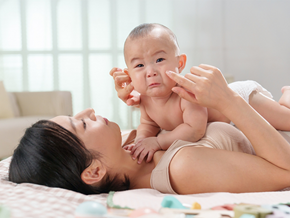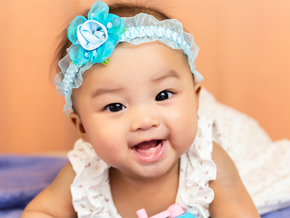
Go to any online parenting communities like ParenTeam's Moms and Dads Facebook group. And you'll discover that many new parents feel unsure about how to burp a newborn when they're looking tiny and fragile.
Some of the common refrains you'll read and hear: "How do I support their head and back?" "Those are hard pats on the back! Won't it hurt my baby?" "How long to burp my newborn?"
The truth is that burping your baby takes practice, and if you don't hear that belch, it doesn't mean anything's wrong. Here's a guide to help you burp your baby with confidence.
How to Burp a Newborn Step by Step
Babies naturally swallow some air while feeding, and that's usually fine. But when there’s too much, it can leave them feeling uncomfortable. According to the Australian Breastfeeding Association (ABA), your baby might grimace or make faces, though it doesn’t always mean they're in pain.
If your baby needs to release air and can't, burping can help release those air bubbles in the stomach. Here's a walk-through of how to burp a newborn safely.
1. Pick your burping position.
There's no single right way to burp your baby, but every position requires supporting your baby's head and neck. Common newborn burping positions recommended by the AAP and the Mount Sinai Parenting Center include:
Over-the-shoulder
This position is the most common way to burp a newborn. You place your baby upright, with their head against your shoulder, and use one hand to support their bottom and the other to pat or rub their back.
Sitting on your lap

Some moms find that sitting their baby on their lap is the ideal newborn burping position to see their baby better.
Sit your baby on your lap facing sideways or slightly forward. Support the chest and head by holding their chin or jaw (not throat) between your thumb and forefinger.
Lying face-down on your lap

Learning how to burp a newborn after feeding takes some trial and error, so you'll need some patience.
Lay your baby tummy-down on your lap. Use one hand to support their head so it's turned to the side and slightly higher than their chest.
2. Pat your baby's back.
Because of their size, your instinct may be to pat your baby softly, but the motion should be firm enough to make a sound.
If you're worried about patting too hard, cup your hand rather than using a flat palm. This newborn burping technique, recommended by UNICEF, makes the touch feel gentler.
Some parents also find that slow, circular rubbing helps release air more easily. The key is steady, rhythmic movement rather than speed.
3. Wait for the burp.
If your baby doesn't burp right away, wait a minute or two and then try another burping position. Some babies burp easily, while others take longer.
If your baby doesn't burp, that's perfectly fine. AAP points out that some babies may not even need to burp. But the medical organization advises to "burp the baby frequently, even if they show no discomfort."
4. Clean up and comfort.
Always keep a small towel or burp cloth handy in case your baby spits up. After burping, hold your baby upright for 10 to 15 minutes to help the milk settle and prevent infant reflux.
FAQs About Burping a Newborn
Here are answers to some of the most common concerns new parents have about burping their babies.
Do I really need to burp my baby?
Based on AAP's guidelines, the short answer is yes. But, as Mount Sinai notes, newborns drink only small amounts of milk, so there's often little air to release. At this stage, the medical center adds, burping serves as practice for both you and your baby.
Some cultures do not burp babies regularly. One possible reason is that babies are often carried upright in baby carriers or slings. Being held in that position helps trapped air rise naturally and escape on its own.
What to do if my newborn is not burping?
Try another burping position. But if your baby doesn't burp after a few minutes, that's okay. The AAP points out that some babies don't need to burp every time.
However, if your baby is extra cranky and crying for prolonged periods, the problem may be colic. Read more in Colic in Babies: Causes, Symptoms, and Soothing Tips.
How long should I burp my newborn?
There really isn't an ideal duration for each burping session because each baby is different. Some little ones burp within seconds, others take longer, or not at all.
In the ParenTeam article on infant reflux, Dr. Adrienne Michelle B. Lu, DPPS, DPSPGHAN, suggests keeping babies upright for at least 30 minutes after feeding. This helps their stomachs empty more quickly.
How to burp my newborn while sleeping?
Burping positions still apply, but keep your movements slow and steady, so you don't startle your baby awake. You can hold them upright against your chest with their head resting securely on your shoulder. Gently pat or rub their back for a minute or two, and let any air bubbles rise.
Like everything related to raising a child, learning how to burp a newborn takes time, patience, and confidence. What works for your friend's baby might not work for yours, and that's perfectly fine.
The good news is that you'll gain, well, burping experience. You'll find your rhythm and the positions that make your baby calm and comfortable. You might even surprise yourself by starting to show other moms how to burp a newborn and telling them, "Good job po, Mama!"
Disclaimer: This article is for educational and informational purposes only. It’s not a substitute for professional medical advice, diagnosis, or treatment. If you have questions about your health or your child's, please talk to your doctor or a qualified healthcare provider. Never ignore or delay getting medical advice because of something you read on this website.
References
HealthyChildren.org. “Baby Burping, Hiccups & Spit-Up.” Accessed November 8, 2025. https://www.healthychildren.org/English/ages-stages/baby/feeding-nutrition/Pages/baby-burping-hiccups-and-spit-up.aspx
HealthyChildren.org. “Baby’s First Month: Feeding and Nutrition.” Accessed November 8, 2025. https://www.healthychildren.org/English/ages-stages/baby/feeding-nutrition/Pages/The-First-Month-Feeding-and-Nutrition.aspx
Nemours KidsHealth. “Burping Your Baby.” Accessed November 8, 2025. https://kidshealth.org/en/parents/burping.html
Pacheco, Danielle, and Danielle Pacheco. “The Best Sleeping Position for a Gassy Baby.” Sleep Foundation, July 29, 2025. Accessed November 8, 2025. https://www.sleepfoundation.org/sleeping-positions/best-sleeping-position-for-gassy-baby
HealthyChildren.org. “Why Babies Spit Up.” Accessed November 8, 2025. https://www.healthychildren.org/English/ages-stages/baby/feeding-nutrition/Pages/Why-Babies-Spit-Up.aspx




























